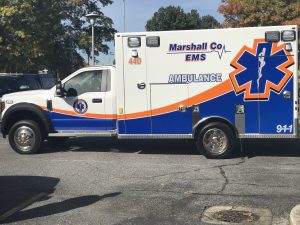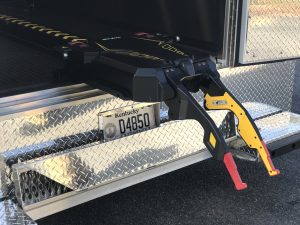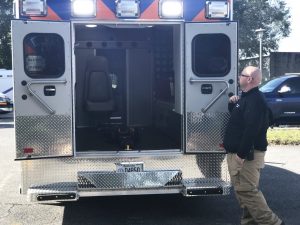
The Marshall County EMS has received a much needed vehicle upgrade this week after the engine blew up in one of their six vehicles. The “box” or the actual ambulance part of the vehicle was remounted onto a new 2018 Ford F450 truck complete with a liquid suspension.
Trucks are routinely rotated out every five years due to the amount of mileage the service puts on vehicles, roughly 250,000-275,000 miles in a five year period. Remounting the box on a new truck instead of purchasing an entirely new unit saves the department between $70,000 and $80,000 per vehicle.
When the motor blew up on one truck before the five year cycle, EMS Director Bryan Cutsinger approached Judge Executive Kevin Neal and received approval from the fiscal court to start the process of acquiring a new truck a few months ahead of schedule.
The addition of a liquid suspension is making it much easier to load patients on stretchers into the ambulance as it automatically lowers the vehicle when the rear doors are opened. A complete inspection will be performed by the state before the new vehicle is officially put into service.
The department has also recently received a grant from the Kentucky Office of Homeland Security to upgrade their units to include the new Stryker power load systems. These systems are now a compliance requirement from the state and all units must be equipped with the new system when a new vehicle is purchased or remounted. Marshall County currently has two of their units upgraded and will be able to upgrade an additional two with the grant money.

“The fiscal court was nice enough to pay for the first two.” Director Bryan Cutsinger explained, “I plan to apply for another grant next year to upgrade the remaining two.”
The department plans to remain proactive in upgrading their units instead of waiting until it is required. “From a safety standpoint we’re trying to get as many as we can as soon as we can” added Captain Steven Criswell.
The Stryker power load systems automatically lift stretchers into the ambulance up to 700 pounds eliminating the need for the responders to lift the patients in themselves. They also secure the stretcher in the ambulance in multiple places making for a more smooth and safe ride. The current equipment only latches the stretcher to the ambulance by one bolt resulting in a somewhat unstable and uncomfortable ride for patients.
“They don’t load nearly as fast as we’re used to doing it, we have to wait on a machine to do it so it’s definitely a learning curve but it is a very good thing” Criswell added.

This is the latest in a series of upgrades after standard manual stretchers were upgraded to power stretchers a few years ago.
